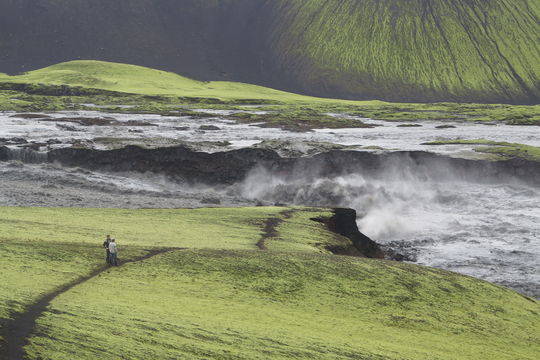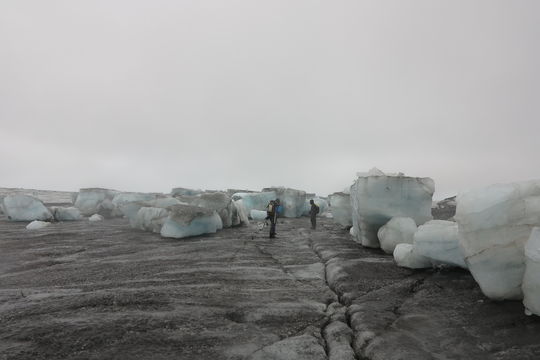Glacial outburst
Glacial outburst floods
Eystri Skaftá jökulhlaup, November 2015. Photo: Tómas Jóhannesson.
Glacial outburst floods (jökulhlaups) are water floods released from ice dammed marginal or subglacial lakes. Subglacial volcanic eruption and other glacier related events can also cause jökulhlaups. These floods are transient events and can last from a few hours up to a few weeks. Whereas glaciers cover about 10% of Iceland, including many of the most active volcanoes, jökulhlaups are frequent. See also Catalogue of Icelandic volcanoes.
Jökulhlaups can be of various sizes, where the maximum discharge and volume of floodwater spans orders of magnitudes. The largest jökulhlaups in historic times, (e.g. outbursts from Mýrdalsjökull caused by Katla eruptions), have had a maximum discharge on the order of 100.000 m3s-1, comparable to the discharge of the Amazon river. The rate of discharge increase during the rising phase of a jökulhlaup is also variable, causing some floods to reach maximum discharge in hours while other take days. Hydrographs of different events, therefore, span a spectrum from rapidly rising jökulhlaups to slowly rising jökulhlaups.
Jökulhlaups can carry various materials other than water, such as eroded ice or sediments, or eruptive material in the case of subglacial volcanic eruptions. Usually solid particles are only a small portion of the flood, but solid material can be a high portion or even the majority of the volume, in special cases. Subglacial volcanic eruptions where solid material accumulates and is then transported with the flow, and floods down steep slopes where lose soil, dust, rocks or other material is incorporated into the flow, are examples of such cases. Floods where the ratio of water and solid material is similar are also called lahars. This name originates from Indonesia, where such floods occur on the slopes of active volcanoes.
| Size of glacial outburst floods | ||
| Category | Size | Maximum flow (m3/s) |
| Subtle flood | 0 | <1.000 |
| Little flood | 1 | 1.000–3.000 |
| Considerable flooding | 2 | 3.000–10.000 |
| Great flooding | 3 | 10.000–30.000 |
| Large flooding | 4 | 30.000–100.000 |
| Catastrophic flooding | 5 | >100.000 |
Eystri Skaftárketill jökulhlaup, November 2015. Chucks of ice were carried with the flood. Photo: Tómas Jóhannesson.
Jökulhlaups can be categorized to different groups depending on their origin:
- Jökulhlaups from ice-dammed marginal lakes. Such lakes often form when an outlet glacier closes off an ice-free side valley. Grænalón is an Icelandic example of such a lake.
- Jökulhlaups from supraglacial lakes which have formed by accumulation of meltwater in depressions on the surface of the glacier. Such floods are generally small in Iceland but can be of substantial magnitude on the Greenland ice sheet.
- Jökulhlaups from subglacial lakes. Such lakes are generally formed due to geothermal activity at the base of a glacier. These settings are common in Iceland and they are the cause of a number of subglacial lakes, i.e. the eastern and western Skaftá ice cauldrons and Grímsvötn.
- Jökulhlaups caused by volcanic eruptions underneath a glacier. Meltwater formed in subglacial eruptions often flows immediately away from the eruption site, but it can also accumulate around the site. Increased accumulation leads to the reservoir becoming unstable and the release of a jökulhlaup. Jökulhlaups from Eyjafjallajökull in 2010 are an example of this type of flood. In large eruptions, such as Katla eruptions underneath Mýrdalsjökull, ice melting can be very rapid and substantial in volume, resulting in large floods.
- Jökulhlaups cause by melting due to hot pyroclastic flow onto snow and ice in explosive eruptions in stratovolcanoes. This type of floods usually starts as an avalanche of hot eruptive material that transforms into a rock flood that converts into a mud flood, as more water is entrained in the flow. This has happened during 20th century eruptions at Hekla.
- Jökulhlaups due to a glacier surge into a proglacial lakes. A glacier that surges into a proglacial lake displaces part of the lake water, which can then flow away and cause a flood. The surge of Hagafellsjökull eystri into Hagafellsvatn in 1999 is an example of this type of event. A small jökulhlaup can furthermore potentially be produced at the end of a surge when an efficient channelized subglacial drainage system redevelops underneath a glacier; this change in configuration releases trapped water from a distributed subglacial drainage system.
- Jökulhlaups caused by land- or rockslides. Substantial potential energy is released in such slides, which can cause melting of ice and creation of flood water if the slide falls onto a glacier. A flood can also be formed by displacing of water if the slide material finds its way into a glacier dammed lake. The rockslide onto Steinsholtsjökull in 1967, and the following flood are an example of this type of event.
Jökulhlaups also occurs in other places of the world where glaciers can be found. For example, in Greenland, the Alps, Antarctica, mountain ranges by the east coast of North- and South-America, the Himalayas, the Altai Mountains, New Zealand, Svalbard and Norway.
The concept “jökulhlaup” is known worldwide among geoscientist and reflects the importance of the theory, which evolved from observations of floods in Iceland.
Photographs of a jökulhlaup in Múlakvísl in July 2011 can be seen here.





